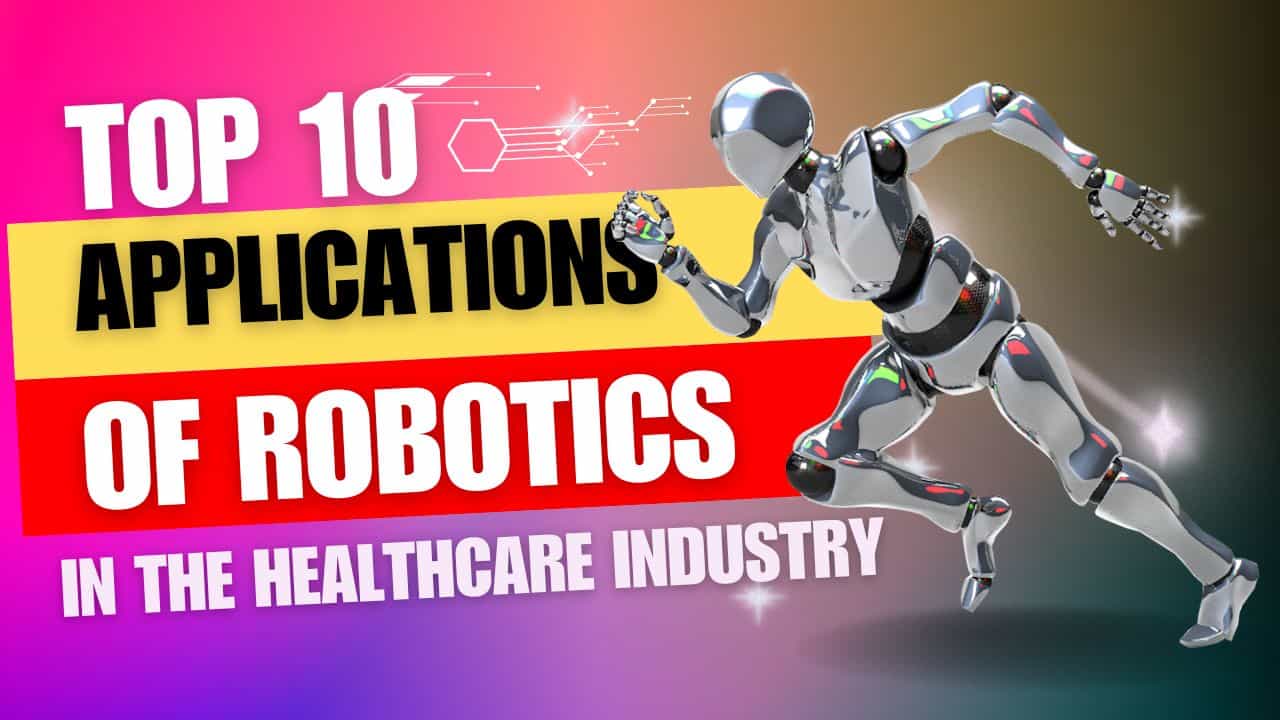In this blog post, we discuss 10 Game-Changing Applications of Robotics in the Healthcare Industry. After reading this blog post, you know all 10 game-changing robotics applications for the healthcare industry.
The integration of robotics into the healthcare industry has the potential to revolutionize patient care, streamline processes, and enhance medical outcomes. Here are ten game-changing applications of robotics in health care:
Definitely! Let us look into the detailed explanation of 10 Game-Changing Applications of Robotics in the Healthcare Industry:
1. Surgical Robotics
Robotic-assisted surgery has revolutionized the field of surgery. Surgeons use robotic systems to perform complex procedures with greater precision and control. These systems include robotic arms with specialized instruments that can mimic the movements of the surgeon’s hands. The surgeon operates the robotic system from a console, which provides a 3D view of the surgical site. Robot-assisted surgery offers several advantages, including smaller incisions, less blood loss, faster recovery times, and better surgical outcomes.
2. Rehabilitation Robotics
Robotics plays an important role in physical therapy and rehabilitation. Robotic devices such as exoskeletons and robotic arms help patients regain mobility and motor function. These devices can help patients perform repetitive movements and exercises, providing feedback and guidance to ensure proper form and technique. Rehabilitation robots enable personalized therapy sessions, track progress, and help individuals regain independence and functionality after injuries or disabilities.
3. Telemedicine Robot
Telepresence robots enable healthcare providers to examine and interact with patients remotely. These robots are equipped with cameras, screens, and audio systems that facilitate real-time communication between doctors and patients. Telemedicine robots are especially beneficial for individuals in remote or under-served areas who have limited access to health services. They enable remote consultation, diagnosis, and monitoring of patients, expanding the reach of healthcare providers and improving patient outcomes.
4. Robotic Pharmacy Automation
Robotic systems are increasingly being used in pharmacies to automate various hospital/medical tasks. These robots can accurately and efficiently dispense medications, manage inventory, and handle prescription filling. Automated pharmacy systems reduce human errors in drug dispensing, ensure accurate dosage calculations, and increase patient safety. Pharmacists can focus more on patient counseling, drug review, and clinical intervention, optimizing their role in health care delivery.
5. Robotic Prosthetics
Advanced robotic prosthetics have transformed the lives of individuals with limb loss or limb variation. These prosthetic devices use sensors, actuators, and advanced control systems to mimic natural limb movements. Robotic prosthetics can be controlled through a variety of mechanisms, including muscle signals or brain-computer interfaces. By providing enhanced functionality and natural motion, these prosthetics empower users to perform complex tasks, improve their quality of life, and restore a sense of independence.
6. Laboratory Automation
Laboratory automation using robots has greatly streamlined laboratory processes. Robots can perform repetitive tasks, such as sample handling, pipetting, and sample processing, with accuracy and consistency. Automated systems improve workflow efficiency, reduce human error, and increase throughput in research laboratories and clinical facilities. It accelerates the pace of scientific discoveries, increases diagnostic accuracy, and enables researchers to focus on data analysis and interpretation.
7. Robot-Assisted Rehabilitation
Robotics is used in the rehabilitation of patients with neurological disorders such as stroke or spinal cord injuries. Robotic devices assist with repetitive training exercises, providing controlled motion and resistance tailored to each patient’s needs. These devices enable intensive and targeted therapy, facilitate motor recovery, improve muscle strength and coordination, and enhance overall rehabilitation outcomes.
8. Robotic Companions and Therapy Robots
Socially assistant robots are designed to provide companionship, emotional support, and cognitive stimulation for individuals, particularly the elderly or those with mental health conditions. These robots can engage in conversations, monitor vital signs, remind patients to take medications and assist with daily tasks. Companion robots help reduce loneliness, encourage social interaction, and provide mental stimulation, contributing to the well-being and quality of life of individuals in need of emotional support.
9. Robotic Diagnostics and Imaging
Robots are employed in medical imaging procedures to increase accuracy, efficiency, and patient comfort. They assist with imaging techniques such as MRI scans, ultrasound exams, and CT scans. Robotic systems precisely position patients, control imaging parameters and obtain high-quality images. It minimizes variability, optimizes imaging results, and minimizes patient discomfort during diagnostic procedures.
10. Robotic Elderly Care
Robots are increasingly being used in nursing homes and elderly care facilities to assist with activities of daily living. These robots can pick up patients, transfer them between beds and wheelchairs, and provide medication schedules and reminders for appointments. By reducing physical stress on caregivers, robotic assistance promotes more efficient care delivery and improves the overall well-being of elderly persons. This allows older adults to maintain independence and dignity while ensuring their safety and comfort.
These ten applications highlight the transformative potential of robotics in health care. From increasing surgical precision to improving rehabilitation outcomes and supporting remote health services, robotics is driving innovation and revolutionizing patient care. As technology advances, we can expect more integration of robotics into healthcare, leading to improved medical practices and better health outcomes for individuals around the world.
We hope after reading this amazing blog post about “10 Game-Changing Applications of Robotics in the Healthcare Industry” you must have got all the important information for this article. For more updated content click on the Study Fiber Blog Website.
